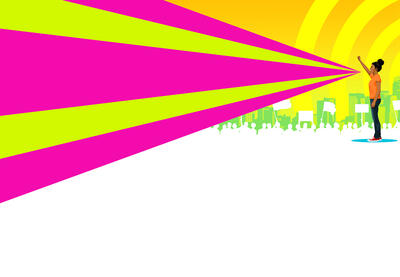At school Kaia felt like she didn’t fit in. Even though her school was in the same Ohio town where she grew up, she still felt she didn’t belong.
Note for adults
This true story addresses police killings of Black people. Ensure that you have classroom norms in place for discussing this subject with children, and be ready to provide support, especially for Black children.
Not many of the other children who went to her school had chocolate-colored hair with tight curls and golden-brown skin like Kaia did.
I wish that I could just snap my fingers and have straight, sunny yellow hair and creamy white skin, like most of the other kids, Kaia thought to herself. Then I wouldn’t feel so different.
She felt worse when she saw how people who looked like her were treated—not just in Bexley, her town, but all across the country.
On the news, she heard the names of more and more people who looked like her—people who were Black and Brown—who were killed by police. And when people tried to explain the reasons why so many people died in this way, it just didn’t make sense.
Does this happen just because they look like me? Kaia wondered.
She felt horrible inside because it kept happening. It hurt so much, but she didn’t say so. Other people didn’t say much about it, either.
Then one day it happened again. But this time, when a video came out and showed how this Black man died, Kaia’s stomach ached so much. She knew she had to do something right away.
Kaia wasn’t the only person who felt terrible. Lots of people, people of all races and ages, clearly saw that what was happening was wrong.
Many people across the country had to do something right away, too, so they marched in the streets where they lived and spoke up.
Kaia joined the people who were marching in her city. She marched downtown to the State Capitol building with all kinds of people—not just people who looked like her—who said this violence must stop.
Then something happened to Kaia. She now felt like she did fit in with the people who spoke up to say that, just like everybody else, Black and Brown people deserve justice.
Kaia no longer wanted to snap her fingers and become anyone other than herself, with her chocolate-colored hair with tight curls and golden-brown skin.
As Kaia heard the crowd grow louder, she found herself saying words she never said before.
“I’m Black and I’m proud!” Kaia cried.
She moved through the crowd gathered in front of the building. She knew she had to tell people how she was feeling in her heart.
Kaia reached the front, and when she started to speak, everyone grew quiet to listen.
“We are mothers. We are fathers. We are sons and we are daughters,” she said, tears falling from her eyes.
The crowd shouted back, “Black lives matter!”
Kaia spoke about the need to fight for justice and the safety of Black and Brown people who continue to be killed by police.
“My life matters,” Kaia said with more tears running down her face, “and my voice deserves to be heard!”
That night, Kaia saw a video that someone took that day. She saw herself speaking to the crowd.
That video shows my real self, Kaia thought. I care about what happens.
Kaia’s friends and family saw her true self, too, and told her to keep using her voice.
“I was there when you were speaking,” said a friend. “You are strong and I am proud of you.”
The next day, people from Kaia’s school invited her to help start a student group, the Bexley Anti-Racism Project, to speak up against the unfair treatment of Black and Brown people.
Nearly 1,000 people came to an event to learn what the students had to say. All kinds of people shouted, cried, laughed and were quiet sometimes, too, when the students spoke about racial justice. Kaia had never seen her community like this.
Then the crowd went together, back to the building downtown, saying, “Black lives matter!”
Kaia not only learned to speak up for racial justice. With the Bexley Anti-Racism Project, she helped other children like her celebrate their own beauty and speak up, too.
Questions for Readers
Right There (In the Text)
Why didn’t Kaia feel like she fit in at her school?
Think and Search (In the Text)
What did Kaia keep hearing on the news, and what did she think about what she heard?
Author and Me (In My Head)
Instead of keeping it to themselves, what can students do about something that they see and know is clearly unfair?
On My Own (In My Head)
Kaia learned that beauty comes in many forms. Who would you talk with if you needed help celebrating the beauty that you have being just the way you are?
